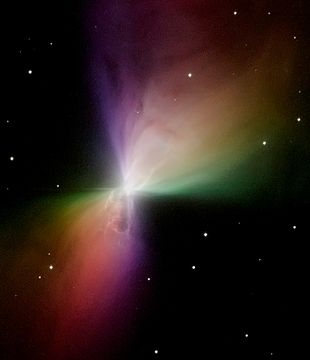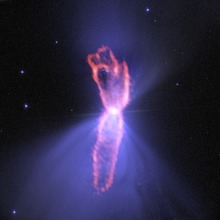Boomerang fog
|
Planetary Nebula Boomerang Nebula |
|
|---|---|

|
|
| Boomerang nebula, imaged by the Hubble Space Telescope with a polarizing filter. | |
| AladinLite | |
| Constellation | centaur |
|
Position equinox : J2000.0 |
|
| Right ascension | 12h 44m 45.45s |
| declination | -54 ° 31 ′ 11.4 ″ |
| Appearance | |
| Angular expansion | 1.45 ′ × 0.72 ′ |
| Central star | |
| Physical data | |
| distance | 5,000 ly |
| history | |
| discovery | Keith Taylor, Mike Scarrott |
| Date of discovery | 1980 |
| Catalog names | |
| ESO 172-7 • | |
The Boomerang Nebula (English: Boomerang Nebula ) is a planetary nebula .
The Boomerang Nebula is located in the constellation Centaur , 5,000 light years from Earth. At 1 Kelvin, the nebula is the coldest place in the universe known outside of a laboratory. The boomerang nebula consists of the gas streams of a star in its core, which repels them. The gas moves away from this star at about 600,000 km / h. This expansion is the reason for the coldness of the fog.

The boomerang nebula was photographed in detail by the Hubble Space Telescope in 1998 .
Keith Taylor and Mike Scarrott named the nebula in 1980 after observing it with a large telescope from Australia. Since they were unable to see exact details of the fog at the time, they suspected that the fog looked like a boomerang. Hence the name.
See also
Individual evidence
- ↑ a b BOOMERANG NEBULA . simbad.u-strasbg.fr. Retrieved September 3, 2011.
- ^ Lars Lindberg Christensen, Robert Fosbury: Hubble: 15 years on a journey of discovery , Wiley-VCH Verlag, 2006, ISBN 978-3-527-40682-1 , page limited preview in the Google book search
